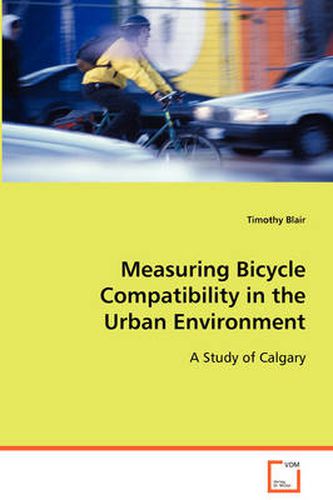Readings Newsletter
Become a Readings Member to make your shopping experience even easier.
Sign in or sign up for free!
You’re not far away from qualifying for FREE standard shipping within Australia
You’ve qualified for FREE standard shipping within Australia
The cart is loading…






This title is printed to order. This book may have been self-published. If so, we cannot guarantee the quality of the content. In the main most books will have gone through the editing process however some may not. We therefore suggest that you be aware of this before ordering this book. If in doubt check either the author or publisher’s details as we are unable to accept any returns unless they are faulty. Please contact us if you have any questions.
Cities are interested in providing facilities that permit their citizens to maximize the mobility options available to them, make efficient use of the transportation network, and enjoy a high quality of life. Measuring the bicycle compatibility of existing streets is critical to understanding how the current network can accommodate cyclists. This Masters Degree Project examines one method by which to assess cyclist compatibility, using an operational model developed by a traffic engineer. This case study modifies an existing model for application to Calgary, by specializing it for urban conditions. When applied to the downtown core of Calgary, the model is used to recommend the most cycling-friendly streets in an area which had no designated routes or facilities intended for cyclists. The model also serves to identify specific problem locations and recommends ways in which these difficulties can be resolved. The paper includes a discussion of the applicability of this operational type model and its usefulness in identifying routes in urban areas that best serve the needs of cyclists.
$9.00 standard shipping within Australia
FREE standard shipping within Australia for orders over $100.00
Express & International shipping calculated at checkout
This title is printed to order. This book may have been self-published. If so, we cannot guarantee the quality of the content. In the main most books will have gone through the editing process however some may not. We therefore suggest that you be aware of this before ordering this book. If in doubt check either the author or publisher’s details as we are unable to accept any returns unless they are faulty. Please contact us if you have any questions.
Cities are interested in providing facilities that permit their citizens to maximize the mobility options available to them, make efficient use of the transportation network, and enjoy a high quality of life. Measuring the bicycle compatibility of existing streets is critical to understanding how the current network can accommodate cyclists. This Masters Degree Project examines one method by which to assess cyclist compatibility, using an operational model developed by a traffic engineer. This case study modifies an existing model for application to Calgary, by specializing it for urban conditions. When applied to the downtown core of Calgary, the model is used to recommend the most cycling-friendly streets in an area which had no designated routes or facilities intended for cyclists. The model also serves to identify specific problem locations and recommends ways in which these difficulties can be resolved. The paper includes a discussion of the applicability of this operational type model and its usefulness in identifying routes in urban areas that best serve the needs of cyclists.